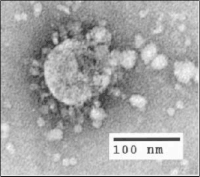
Photo from wikipedia
After the increasing number of severe acute respiratory syndrome coronavirus 2 (SARS-CoV-2) infections all over the world, researchers and clinicians are struggling to find a vaccine or innovative therapeutic strategies… Click to show full abstract
After the increasing number of severe acute respiratory syndrome coronavirus 2 (SARS-CoV-2) infections all over the world, researchers and clinicians are struggling to find a vaccine or innovative therapeutic strategies to treat this viral infection. The severe acute respiratory syndrome coronavirus infection that occurred in 2002, Middle East respiratory syndrome (MERS) and other more common infectious diseases such as hepatitis C virus, led to the discovery of many RNA-based drugs. Among them, siRNAs and antisense locked nucleic acids have been demonstrated to have effective antiviral effects both in animal models and humans. Owing to the high genomic homology of SARS-CoV-2 and severe acute respiratory syndrome coronavirus (80–82%) the use of these molecules could be employed successfully also to target this emerging coronavirus. Trying to translate this approach to treat COVID-19, we analyzed the common structural features of viral 5’UTR regions that can be targeted by noncoding RNAs and we also identified miRNAs binding sites suitable for designing RNA-based drugs to be employed successfully against SARS-CoV-2.
Journal Title: Epigenomics
Year Published: 2020
Link to full text (if available)
Share on Social Media: Sign Up to like & get
recommendations!